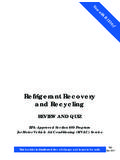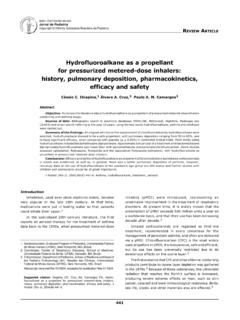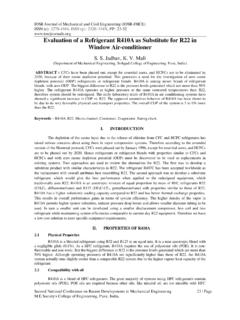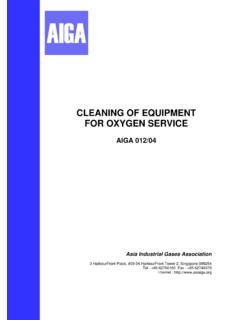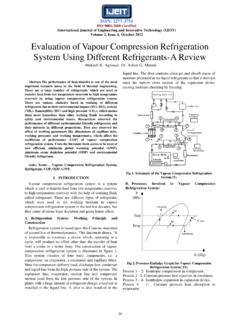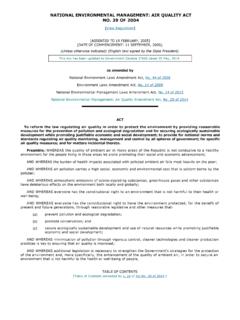Transcription of Ozone Layer Depletion and Its Effects: A Review
1 International Journal of Environmental Science and Development, , , February 2011 ISSN: 2010-0264 30 Abstract - There are many situations where human activities have significant effects on the environment. Ozone Layer damage is one of them. The objective of this paper is to Review the origin, causes, mechanisms and bio effects of Ozone Layer Depletion as well as the protective measures of this vanishing Layer . The chlorofluorocarbon and the halons are potent Ozone depletors.
2 One of the main reasons for the widespread concern about Depletion of the Ozone Layer is the anticipated increase in the amounts of ultraviolet radiation received at the surface of the earth and the effect of this on human health and on the environment. The prospects of Ozone recovery remain uncertain. In the absence of other changes, stratospheric Ozone abundances should rise in the future as the halogen loading falls in response to regulation. However, the future behaviour of Ozone will also be affected by the changing atmospheric abundances of methane, nitrous oxide, water vapour, sulphate aerosol, and changing climate.
3 Index Terms Bio effects, chlorofluorocarbon, Ozone Layer Depletion , Protection. I. INTRODUCTION The Ozone Layer is a Layer in Earth's atmosphere which contains relatively high concentrations of Ozone (O3). This Layer absorbs 93-99% of the sun's high frequency ultraviolet light, which is potentially damaging to life on earth [1]. Over 91% of the Ozone in Earth's atmosphere is present here.[1] It is mainly located in the lower portion of the stratosphere from approximately 10 km to 50 km above Earth, though the thickness varies seasonally and geographically[2].
4 The Ozone Layer was discovered in 1913 by the French physicists Charles Fabry and Henri Buisson. Its properties were explored in detail by the British meteorologist G. M. B. Dobson, who developed a simple spectrophotometer (the Dobson meter) that could be used to measure stratospheric Ozone from the ground. Between 1928 and 1958 Dobson established a worldwide network of Ozone monitoring stations which continues to operate today. The "Dobson unit", a convenient measure of the total amount of Ozone in a column overhead, is named in his honor.
5 A. Ozone Without Ozone , life on Earth would not have evolved in the way it has. The first stage of single cell organism development requires an oxygen-free environment. This type of environment existed on earth over 3000 million years ago. As the primitive forms of plant life multiplied and evolved, Manuscript Received, 27 November, 2010. * and Kumar Reddy, - Thermal Engineering,, Department of Mechanical Engineering,, Silchar, Assam, India *Email: they began to release minute amounts of oxygen through the photosynthesis reaction (which converts carbon dioxide into oxygen) [3].
6 The buildup of oxygen in the atmosphere led to the formation of the Ozone Layer in the upper atmosphere or stratosphere. This Layer filters out incoming radiation in the "cell-damaging" ultraviolet (UV) part of the spectrum. Thus with the development of the Ozone Layer came the formation of more advanced life forms. Ozone is a form of oxygen. The oxygen we breathe is in the form of oxygen molecules (O2) - two atoms of oxygen bound together. Normal oxygen which we breathe is colourless and odourless.
7 Ozone , on the other hand, consists of three atoms of oxygen bound together (O3). Most of the atmosphere's Ozone occurs in the region called the stratosphere. Ozone is colourless and has a very harsh odour. Ozone is much less common than normal oxygen. Out of 10 million air molecules, about 2 million are normal oxygen, but only 3 are Ozone . Most Ozone is produced naturally in the upper atmosphere or stratosphere. While Ozone can be found through the entire atmosphere, the greatest concentration occurs at altitudes between 19 and 30 km above the Earth's surface.
8 This band of Ozone -rich air is known as the " Ozone Layer ". [4] Ozone also occurs in very small amounts in the lowest few kilometres of the atmosphere, a region known as the troposphere. It is produced at ground level through a reaction between sunlight and volatile organic compounds (VOCs) and nitrogen oxides (NOx), some of which are produced by human activities such as driving cars. Ground-level Ozone is a component of urban smog and can be harmful to human health. Even though both types of Ozone contain the same molecules, their presence in different parts of the atmosphere has very different consequences.
9 Stratospheric Ozone blocks harmful solar radiation - all life on Earth has adapted to this filtered solar radiation. Ground-level Ozone , in contrast, is simply a pollutant. It will absorb some incoming solar radiation, but it cannot make up for Ozone losses in the stratosphere. B. Ozone Hole In some of the popular news media, as well as in many books, the term " Ozone hole" has and often still is used far too loosely.
10 Frequently, the term is employed to describe any episode of Ozone Depletion , no matter how minor. Unfortunately, this sloppy language trivializes the problem and blurs the important scientific distinction between the massive Ozone losses in Polar Regions and the much smaller, but nonetheless significant, Ozone losses in other parts of the world. Technically, the term " Ozone hole" should be applied to regions where stratospheric Ozone Depletion is so severe that levels fall below 200 Dobson Units ( ), the traditional measure of stratospheric Ozone .



